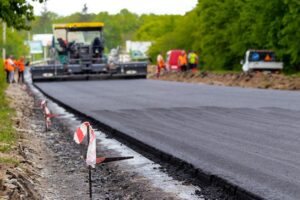How Infrastructure Development Impacts Economic Growth
Infrastructure development refers to the construction and improvement of physical structures, such as roads, bridges, airports, seaports, and railways, that support economic activity. The importance of infrastructure development cannot be overstated, as it is the backbone of any economy, facilitating the movement of goods and services, people, and information. In this blog post, we will explore how infrastructure development impacts economic growth and the benefits that accrue to communities and countries that invest in infrastructure.
A. Explanation of the importance of infrastructure development:
Infrastructure development is a critical component of any economy as it supports economic activities such as trade, commerce, and tourism. It facilitates the movement of goods and services, enabling businesses to reach their markets and consumers to access essential goods and services. Additionally, infrastructure development improves access to basic services, such as healthcare and education, and enhances the overall quality of life for citizens.
B. Brief overview of the economic benefits of infrastructure development:
Infrastructure development has numerous economic benefits, including increased productivity, job creation, and improved connectivity, among others. Improved connectivity, for example, opens up new markets, expands trade, and creates opportunities for growth. Infrastructure development also attracts foreign direct investment, which drives economic growth and creates jobs.
In the following sections, we will delve deeper into the economic benefits of infrastructure development, including improved accessibility and connectivity, job creation, increased productivity, and foreign direct investment. We will also examine case studies and examples of infrastructure projects that have had a significant impact on economic growth.
Improved Accessibility and Connectivity
A. Explanation of how infrastructure development improves accessibility and connectivity:
Infrastructure development improves accessibility and connectivity by reducing transportation costs, travel time, and other logistical barriers that hinder economic activities. For example, new highways or upgraded transportation systems can reduce the travel time between two cities, making it easier and less expensive for businesses to transport goods and people. Similarly, the development of new seaports or airports can open up new trade routes and markets, creating opportunities for businesses to expand their operations.
B. Economic benefits of improved accessibility and connectivity:
Improved accessibility and connectivity have numerous economic benefits. By reducing transportation costs and time, businesses can operate more efficiently and effectively, lowering the cost of doing business and increasing profits. Improved accessibility and connectivity also attract new businesses, creating employment opportunities and stimulating economic growth.
C. Case studies or examples of infrastructure projects that have improved accessibility and connectivity and their impact on economic growth:
One example of how infrastructure development improves accessibility and connectivity is the construction of the Trans-Alaska Pipeline System (TAPS). The TAPS is a 800-mile-long pipeline that connects Alaska’s North Slope oil fields with the Valdez Marine Terminal, where the oil is loaded onto tankers and shipped to refineries around the world. Before the TAPS, shipping oil from Alaska was extremely difficult and expensive, with the only option being to transport the oil by icebreaking tanker ships. With the construction of the TAPS, transportation costs were significantly reduced, making it more profitable to extract and transport oil from Alaska’s North Slope. This led to an increase in oil production and exports, creating jobs and stimulating economic growth.
Another example is the development of the Dubai International Airport. The airport’s expansion and modernization allowed it to become a major hub for international flights, connecting the Middle East to Asia, Europe, and the Americas. This led to an increase in tourism, trade, and investment in Dubai, boosting the emirate’s economy and creating thousands of jobs in the aviation and hospitality industries.
These examples demonstrate how infrastructure development, particularly improvements in accessibility and connectivity, can have a significant impact on economic growth. By reducing transportation costs and opening up new markets and trade routes, infrastructure development creates opportunities for businesses to expand their operations and increase profits, leading to job creation and economic growth.
Job Creation
A. Explanation of how infrastructure development leads to job creation:
Infrastructure development leads to job creation through direct and indirect employment opportunities. Direct jobs are created during the construction and maintenance of infrastructure projects, such as road construction, bridge building, and airport expansion. Indirect jobs are created through the economic activities that infrastructure development enables, such as increased trade and tourism. For example, the construction of a new airport can create direct jobs for construction workers and engineers, as well as indirect jobs for taxi drivers, hotel staff, and restaurant workers who serve travelers.
B. Economic benefits of job creation:
Job creation is one of the most significant economic benefits of infrastructure development. By providing employment opportunities, infrastructure development helps to reduce unemployment and poverty, which in turn boosts consumer spending and supports economic growth. Job creation also helps to improve social and economic outcomes, such as increased access to education, healthcare, and housing.
C. Case studies or examples of infrastructure projects that have created jobs and their impact on economic growth:
One example of how infrastructure development creates jobs is the construction of the Golden Gate Bridge in San Francisco. The project employed thousands of workers and engineers, providing employment opportunities during the Great Depression. Once completed, the Golden Gate Bridge became a major tourist attraction, creating indirect jobs in the tourism industry and contributing to the economic growth of the region.
Another example is the construction of the High-Speed Rail (HSR) in China. The HSR project created over 100,000 jobs during its construction phase and has since created many more indirect jobs in the manufacturing, service, and hospitality industries. The HSR has significantly reduced travel times between major cities, making it easier for businesses to expand their operations and for tourists to visit different parts of the country, contributing to the economic growth of China.
These examples demonstrate how infrastructure development can create significant job opportunities, contributing to economic growth and improving social and economic outcomes. By creating direct and indirect employment opportunities, infrastructure development helps to reduce poverty and increase consumer spending, supporting economic growth and improving the quality of life for citizens.
Increased Productivity
A. Explanation of how infrastructure development increases productivity:
Infrastructure development increases productivity by improving the efficiency of economic activities. For example, the construction of new highways or rail networks can reduce transportation costs and travel times, making it easier and less expensive for businesses to transport goods and people. Similarly, the development of new telecommunications and internet networks can improve connectivity and communication, allowing businesses to operate more efficiently and effectively.
B. Economic benefits of increased productivity:
Increased productivity has numerous economic benefits. By reducing costs and improving efficiency, businesses can increase profits and invest in further growth and innovation. Increased productivity also creates a competitive advantage, allowing businesses to offer better products and services at lower prices, stimulating consumer spending and driving economic growth.
C. Case studies or examples of infrastructure projects that have increased productivity and their impact on economic growth:
One example of how infrastructure development increases productivity is the construction of the Erie Canal in the early 19th century. The canal connected the Great Lakes region to the Atlantic Ocean, providing a more efficient and cost-effective way to transport goods between the Midwest and the East Coast. This led to a significant increase in trade and commerce, creating new markets and opportunities for businesses to expand their operations, stimulating economic growth.
Another example is the development of high-speed internet networks in South Korea. The country has invested heavily in developing its internet infrastructure, making it one of the most connected countries in the world. This has enabled businesses to operate more efficiently and effectively, improving productivity and competitiveness. The development of South Korea’s internet infrastructure has also led to the emergence of new industries, such as online gaming and e-commerce, creating employment opportunities and stimulating economic growth.
These examples demonstrate how infrastructure development, particularly improvements in transportation and telecommunications, can increase productivity, creating opportunities for businesses to expand their operations and increase profits, leading to job creation and economic growth.
Foreign Direct Investment
A. Explanation of how infrastructure development attracts foreign direct investment:
Infrastructure development attracts foreign direct investment (FDI) by improving the ease of doing business and reducing the risks associated with investing in a particular country. Infrastructure development, such as the construction of highways, ports, and airports, can improve transportation and logistics, making it easier and less expensive for foreign businesses to transport goods and people. Similarly, the development of reliable and efficient telecommunications networks can improve communication and connectivity, reducing the costs and risks associated with doing business in a foreign country.
B. Economic benefits of foreign direct investment:
FDI has numerous economic benefits. It can create employment opportunities, increase productivity, stimulate innovation and technology transfer, and promote economic growth. FDI can also lead to increased competition and market efficiency, which can benefit consumers by offering better products and services at lower prices.
C. Case studies or examples of infrastructure projects that have attracted foreign direct investment and their impact on economic growth:
One example of how infrastructure development attracts FDI is the construction of the Dubai International Airport. The airport has become a major hub for international travel, connecting the Middle East to other regions of the world. The development of the airport has attracted foreign airlines, businesses, and tourists, contributing to the economic growth of the region. The airport has also created direct and indirect job opportunities, stimulating employment and economic growth.
Another example is the development of the Suzhou Industrial Park in China. The park was developed in the early 1990s, and since then has become a major destination for foreign businesses investing in China. The park has state-of-the-art infrastructure, including roads, bridges, and telecommunications networks, making it easier and more attractive for foreign businesses to operate. The development of the Suzhou Industrial Park has attracted significant FDI, stimulating economic growth and creating employment opportunities.
These examples demonstrate how infrastructure development can attract foreign direct investment, stimulating economic growth and creating employment opportunities. By improving the ease of doing business and reducing the risks associated with investing in a particular country, infrastructure development can promote economic development and improve the quality of life for citizens.
Conclusion
A. Recap of the economic benefits of infrastructure development:
Infrastructure development plays a critical role in promoting economic growth and development. Improved accessibility and connectivity, job creation, increased productivity, and foreign direct investment are just some of the economic benefits associated with infrastructure development. By reducing costs, improving efficiency, and increasing competitiveness, infrastructure development can stimulate economic growth and improve the quality of life for citizens.
B. Call to action for increased investment in infrastructure development:
Given the economic benefits associated with infrastructure development, there is a need for increased investment in this area. Governments, businesses, and other stakeholders should prioritize infrastructure development to promote economic growth and development. This could involve increasing funding for infrastructure projects, implementing policies to attract foreign investment, and encouraging public-private partnerships to finance infrastructure projects.
In conclusion, infrastructure development plays a critical role in promoting economic growth and development. By improving accessibility and connectivity, creating jobs, increasing productivity, and attracting foreign investment, infrastructure development can stimulate economic growth and improve the quality of life for citizens. Increased investment in infrastructure development is necessary to ensure continued economic growth and development, and stakeholders must work together to prioritize this important area.



